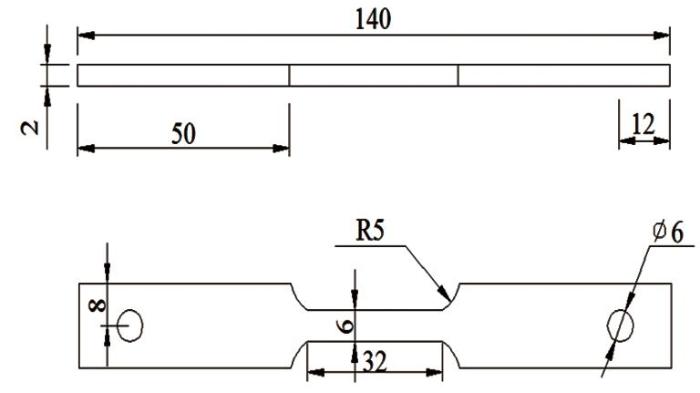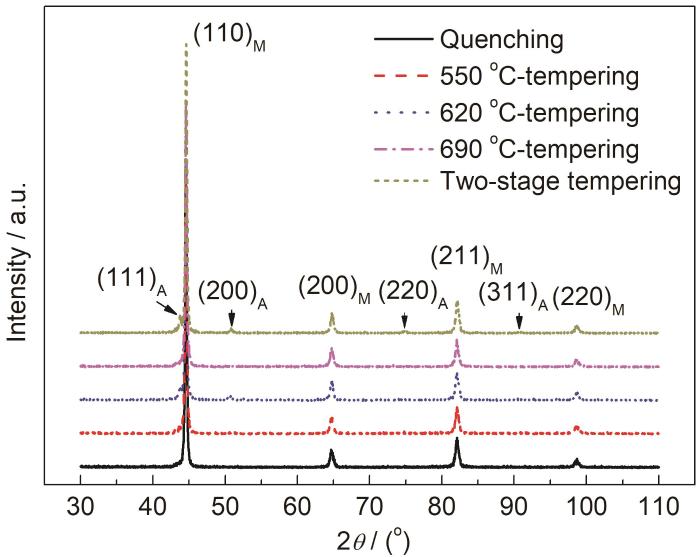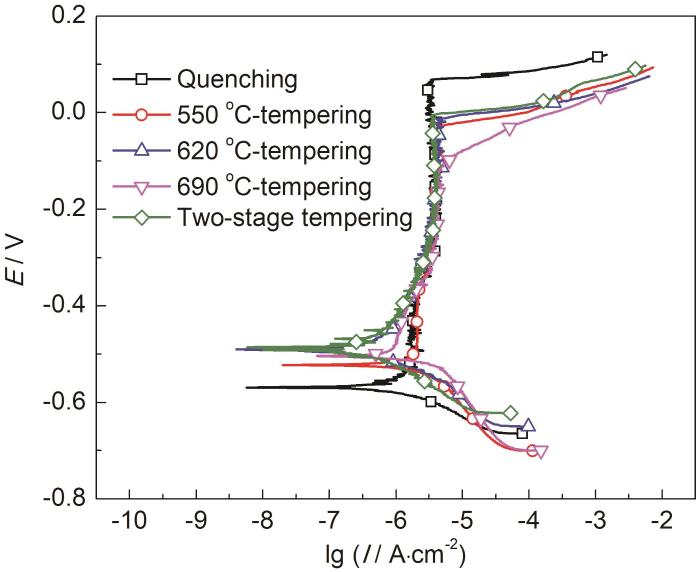超级13Cr不锈钢是一类含13%Cr、5%Ni及2%Mo的超低碳马氏体不锈钢,其基体显微组织为具有优越强度和韧性的回火马氏体[1-4]。通常采用淬火加回火处理来获得理想的细晶回火马氏体[5]。回火过程中产生的逆变奥氏体 (RA) 会减弱析出相对马氏体不锈钢耐蚀性的影响。Kimura等[6]研究发现相比于淬火马氏体,低温回火过程可以降低超级13Cr不锈钢的点蚀电位,并且热处理过程中析出元素的数量随着回火温度的升高而减小,导致超级13Cr点蚀电位上升。回火过程中产生的逆变奥氏体提高了超级13Cr不锈钢的耐蚀性。Gervasi等[7]的实验表明13Cr不锈钢进行不同温度回火后产生了含量不同的逆变奥氏体,逆变奥氏体含量更多的试样表现出更加的耐蚀性。他们认为逆变奥氏体对钝化膜的厚度及成膜速度产生正向影响,逆变奥氏体既增加了材料表面钝化膜的厚度,也加快钝化膜形成过程,进而提高13Cr不锈钢耐蚀性。而何潇等[8]研究了15Cr超级马氏体不锈钢点蚀性能表明第二相的析出降低了试样的点蚀温度。
CO2是油气田中常见的酸性气体。有研究证实[9,10],在pH相同时,相比于盐酸溶液,CO2水溶液对材料腐蚀的影响更剧烈。超级13Cr马氏体不锈钢以其优良的力学性能、极高的抗腐蚀性和较少的资金投入,适用于石油产业的各个领域。然而,超级13Cr马氏体不锈钢一旦长时间暴露于CO2环境中,表面就会发生均匀腐蚀、点蚀等腐蚀行为[11-14]。刘亚娟等[15]模拟了油田超深超高压高温油气井腐蚀环境,发现随着温度和CO2压力升高,超级13Cr不锈钢均匀腐蚀速率增加;同一井深条件气相均匀腐蚀和点蚀的腐蚀速率均大于液相。刘艳朝等[12]和韩燕等[16]的研究也得出了类似结论。朱达江等[17]对不同型号钢管的耐蚀性做出了对比,认为随着CO2分压的增大13Cr马氏体不锈钢的平均腐蚀速率先增大后减小。Anselmo等[18]模拟了含CO2的海水环境,表明随着温度升高,超级13Cr马氏体不锈钢腐蚀情况加剧。截至目前,科研人员对超级13Cr马氏体不锈钢CO2腐蚀的研究多关注于温度、压力等外部环境的影响。热处理工艺对超级13Cr不锈钢CO2腐蚀行为影响的研究较少。本文利用金相显微镜观察了不同热处理条件下超级13Cr的金相组织;采用X射线衍射 (XRD) 分析了不同热处理条件对各试样的物相组成的影响;通过动电位极化曲线,电化学阻抗 (EIS) 技术以及慢应变速率拉伸实验 (SSRT) 等方法研究了热处理工艺对超级13Cr马氏体不锈钢在饱和CO2油田地层水中腐蚀行为的影响,研究结果可以为超级13Cr的工程应用提供借鉴。
1 实验方法
实验材料为超级13Cr不锈钢样品,其化学成分 (质量分数,%) 为C:0.027;P/S:0.03;Si:0.23;Mn:0.41;Mo:0.95;Ni:2.6;Cr:13.3。在供货态材料中心取样。在箱式电阻炉中进行热处理,热处理工艺如表1所示。
表1 超级13Cr不锈钢的热处理工艺
Table 1
| Sample number | Heat treatment condition |
|---|---|
| A | 1050 ℃×0.5 h oil cooling |
| B | 1050 ℃×0.5 h water cooling +550 ℃×6 h furnace cooled |
| C | 1050 ℃×0.5 h water cooling+620 ℃×6 h furnace cooled |
| D | 1050 ℃×0.5 h water cooling+690 ℃×6 h furnace cooled |
| E | 1050 ℃×0.5 h oil cooling+650 ℃×2 h furnace cooled+620 ℃×6 h furnace cooled |
将热处理过的材料线切割成尺寸为10 mm×10 mm×2 mm的薄片,作为金相试样和电化学试样。将试样用SiC水砂纸从80#逐级打磨至2000#,用丙酮去除表面油污,用无水乙醇和去离子水冲洗后吹干。电化学试样背面用铜导线点焊,用环氧树脂封装,留出尺寸为10 mm×10 mm的工作面。经人造金刚石抛光膏抛光薄片表面后,用侵蚀液 (10 mL 37%HCl+10 g FeCl3+90 mL纯水) 侵蚀试样3 min,用金相显微镜 (Leica QM500型) 观察显微组织,并利用XRD分析仪 (X-MAX65T型) 分析不同热处理工艺试样的物相。
实验溶液为油田地层水溶液,其化学组分 (g/L) 为:MgCl2·6H2O 3.572,CaCl2 9.786,NaCl 38.012, NaHCO3 0.136,KCl 0.25,Na2SO4 0.142。实验前向油田地层水溶液通入CO2至饱和。
电化学实验使用Zahner电化学工作站,采用三电极体系,工作电极为超级13Cr马氏体不锈钢,辅助电极为铂片,参比电极为饱和甘汞电极 (SCE) 。所有电化学实验前先将工作电极置于-1.0 V (vs.SCE) 下极化3 min,去除试样的钝化膜。待电位稳定后开始电化学测试。电化学阻抗谱 (EIS) 测试频率为105~10-2 Hz,交流激励信号为10 mV。动电位极化测试的起始电位为-0.25 V (vs.OCP),当腐蚀电流密度大于1 mA/cm2时停止测试,扫描速率0.667 mV/s。
线切割热处理后SSRT试样,尺寸如图1所示,慢应变速率拉伸实验前先用80-2000#砂纸轴向打磨试样,保持试样表面光滑。实验温度为室温,应变速率为1×10-6 mm/s。试样断裂后,根据式 (
图1
其中,L0和L为试样原始和断后长度,mm;A0和A为试样原始和断后横截面积,mm2。
2 实验结果
2.1 不同热处理工艺下超级13Cr不锈钢的显微组织
不同热处理工艺下超级13Cr不锈钢显微组织结构如图2所示。可以清晰地看出,经淬火处理的超级13Cr不锈钢的显微组织为板条状马氏体,与回火试样相比,淬火试样的晶粒更加粗大,且原奥氏体晶粒尺寸各不相同。每个奥氏体晶粒中存在多个位向不同的马氏体束,相同束内的马氏体取向基本一致。经不同温度回火处理的试样均保持马氏体组织,原奥氏体晶粒中存在多个位向不同的马氏体束。通过对比可以发现,马氏体晶粒的大小随回火温度增加而细化。经过620 ℃回火处理的试样,马氏体板条已经相当细化。同时在3种回火处理条件下,原奥氏体晶粒尺寸随回火温度增加而增加,当回火温度为690 ℃时,原奥氏体晶粒尺寸与淬火状态基本相同。经二次回火处理的试样仍表现为回火马氏体组织,但马氏体板条被进一步细化,原奥氏体晶粒尺寸与620 ℃回火试样无明显差别。
图2
图2
不同热处理条件下超级13Cr不锈钢的金相组织形貌
Fig.2
Microstructure morphologies of super 13Cr stainless steel after heat treatments under the conditions of quenching (a), tempering at 550 ℃ (b), 620 ℃ (c) and 690 ℃ (d), and two-stage tempering (e)
2.2 不同热处理工艺下超级13Cr不锈钢的相组成
图3为经不同热处理的13Cr不锈钢试样的XRD谱图。看出,经淬火处理、550 ℃和690 ℃回火处理后只存在马氏体衍射峰,未见奥氏体衍射峰;而经620 ℃回火 (编号C) 和二次回火 (编号E) 处理试样中可以发现明显的奥氏体衍射峰。
图3
图3
经不同条件热处理后超级13Cr不锈钢的XRD图谱
Fig.3
XRD patterns of Super 13Cr stainless steel samples after heat treatments under different conditions
通过MDI Jade6软件得出XRD图谱中衍射峰的积分强度后,经
其中,Vγ 为逆变奥氏体体积分数;Iγ 为 (111)A峰的积分强度;Iα 为 (110)M峰的积分强度。
2.3 超级13Cr不锈钢在饱和CO2油田地层水溶液中电化学行为
超级13Cr不锈钢在饱和CO2油田地层水溶液中的极化曲线如图4所示,表2为极化曲线拟合结果。可以看出,经不同条件热处理的超级13Cr不锈钢在模拟环境中均具有明显的钝化区间,说明各热处理条件下的超级13Cr不锈钢在溶液中存在钝化行为。维钝电流密度Ip大小基本不随热处理工艺变化而变化。淬火试样的钝化区间最大,点蚀电位Ep最高。回火试样的Ep电位均低于淬火试样,550 ℃、620 ℃及二次回火处理试样的Ep电位相近,而690 ℃回火处理试样的Ep电位显著降低。由此可见,淬火试样耐蚀性最好,超级13Cr不锈钢经回火处理后耐蚀性能减弱。当回火温度从550 ℃升高到620 ℃时,超级13Cr不锈钢的耐蚀性逐渐增大,温度继续升高到690 ℃时,耐蚀性逐渐降低。二次回火可以显著增强材料的耐腐蚀性能,这与超级13Cr不锈钢经热处理后产生逆变奥氏体的含量有关。
图4
图4
经不同条件热处理的超级13Cr不锈钢在饱和CO2油田地层水中的极化曲线
Fig.4
Polarization curves of various heat-treated super 13Cr stainless steel in CO2-saturated oilfield formation solution
表2 极化曲线的拟合结果
Table 2
| Heat treatment condition | Ip / μA·cm-2 | Ep / V |
|---|---|---|
| Quenching | 2.96 | 0.05 |
| 550 ℃-tempering | 4.47 | -0.04 |
| 620 ℃-tempering | 4.26 | -0.02 |
| 690 ℃-tempering | 4.52 | -0.12 |
| Two-stage tempering | 3.89 | 0 |
图5
图5
经不同条件热处理的超级13Cr不锈钢在饱和CO2油田地层水中的EIS图及等效电路
Fig.5
Nyquist (a), Bode (b) plots of various heat-treated super 13Cr stainless steel in CO2-saturated oilfield formation solution and Equivalent circuit diagram (c)
表3 不同条件热处理的超级13Cr不锈钢EIS拟合结果
Table 3
| Heat treatment conditions | RsΩ·cm-2 | RfΩ·cm-2 | CPEdlF·cm-2 | RctΩ·cm-2 |
|---|---|---|---|---|
| quenching | 5.73 | 29.40 | 9.74×10-6 | 6.38×104 |
| 550 ℃-tempering | 4.40 | 7.64 | 1.26×10-5 | 3.23×104 |
| 620 ℃-tempering | 4.70 | 16.93 | 1.21×10-5 | 5.30×104 |
| 690 ℃-tempering | 4.52 | 3.22 | 1.79×10-5 | 2.69×104 |
| Two-stage tempering | 5.34 | 19.04 | 1.14×10-5 | 5.52×104 |
CO2溶于水后,与水形成碳酸并发生双重电离,反应如下:
在饱和CO2的溶液中,阴极反应为[22]:
2.4 超级13Cr不锈钢在饱和CO2油田地层水溶液中应力腐蚀行为
图6
图6
经不同条件热处理的超级13Cr不锈钢在饱和CO2油田地层水中的SSRT曲线及断面收缩率及延伸率
Fig.6
SSRT curves (a) and reductions of area and elongations (b) of various heat-treated super 13Cr stainless steel in CO2-saturated oilfield formation solution
为了进一步分析超级13Cr不锈钢的断裂类型,对试件的主、侧断口放大后进行观察。图7是不同热处理超级13Cr不锈钢在SSRT实验后主、侧断口的SEM图。可以看出,淬火试样主断口存在解理面,为脆性沿晶断裂;550 ℃回火试样主断口为解理台阶与韧窝共存,为混合断裂;620 ℃回火及二次回火试样主断口均存在明显的韧窝,但韧窝深度和尺寸较小,故620 ℃回火试样是以韧性断裂为主的混合断裂。690 ℃回火处理试样的断口较为平整,脆性断裂特征明显。所有试样的侧断口均存在二次裂纹。因此,超级13Cr不锈钢在饱和CO2油田地层水中均表现出SCC敏感性。
图7
图7
经不同条件热处理的超级13Cr不锈钢主断口及侧断口形貌
Fig.7
SEM images of the main fractures and side fractures of super 13Cr stainless steel with heat treatments under the conditions of quenching (a1, a2), tempering at 550 ℃ (b1, b2), 620 ℃ (c1, c2) and 690 ℃ (d1, d2) and two-stage tempering (e1, e2)
通过对比可见,与回火试样相比,淬火试样表现出更明显的SCC敏感性。这是由于淬火试样的微观组织为板条状马氏体,断裂抗力较低,且淬火试样基体内部仍存在较高的内应力,这将导致永久滑移带的产生,显著提高材料的SCC敏感性[26]。此外,在饱和CO2溶液中,阴极反应主要为析氢反应,与回火马氏体相比,H更容易在淬火马氏体中扩散,诱发材料脆化,加速裂纹的扩展[27],因此淬火试样展现出明显的沿晶断裂特征。超级13Cr不锈钢经回火处理后产生逆变奥氏体。逆变奥氏体溶氢量较大,且H在逆变奥氏体中扩散系数较低,阻碍了H在裂纹尖端富集[28],削弱了超级13Cr不锈钢的SCC敏感性。由于620 ℃及二次回火试样组织中逆变奥氏体含量较高,SCC敏感性降低。因此,超级13Cr不锈钢在饱和CO2油田地层水中,淬火试样、550 ℃和690 ℃回火试样的SCC机制为氢致开裂,而620 ℃回火及二次回火试样的SCC机制为以韧性断裂为主的混合断裂机制。
3 结论
(1) 超级13Cr不锈钢经620 ℃回火处理后产生逆变奥氏体,二次回火能够增加材料中逆变奥氏体的含量。
(2) 不同热处理工艺的超级13Cr不锈钢在含CO2的油田地层水的极化曲线中均存在明显的钝化区间,回火工艺使超级13Cr不锈钢耐蚀性下降,但二次回火能够提高材料耐蚀性。超级13Cr不锈钢耐蚀性与逆变奥氏体含量有关。
(3) 超级13Cr不锈钢的热处理工艺应选择620 ℃回火及二次回火,从而获得最佳的韧性和耐蚀性能。
(4) 超级13Cr不锈钢在含CO2的油田地层水溶液中存在SCC敏感性。其中淬火试样SCC敏感性最高,淬火试样、550和690 ℃回火试样的SCC机制为氢致开裂,620 ℃回火及二次回火试样因逆变奥氏体的存在,SCC敏感性降低,其开裂机制为以韧性断裂为主的混合断裂机制。
参考文献
Impact of reversed austenite on the pitting corrosion behavior of super 13Cr martensitic stainless steel
[J].
Effect of heat treatment process on microstructure and tensile properties of super 13Cr stainless steel
[J].
热处理对超级13Cr不锈钢组织及拉伸性能的影响
[J].
CO2 corrosion behaviors of 13Cr steel in the high-temperature steam environment
[J].
Stress corrosion crack evaluation of super 13Cr tubing in high-temperature and high-pressure gas wells
[J].Super 13Cr is widely used for oil country tubular goods (OCTG) in wet CO2 environments with small amounts of H2S. This paper presents a case study of super 13Cr tubing that failed due to stress corrosion cracking (SCC). X-ray diffraction (XRD), energy dispersive spectrometry (EDS), scanning electron microscopy (SEM), optical microscopy (OM), and fluorescent magnetic particle inspection were used to investigate the failure mechanism. The results show that the inclusions, metallographic structure, yield strength, and tensile strength of the tubing meet the standard requirements. Furthermore, cracking analysis of the tubing shows that both secondary cracks propagating along grain boundaries and tree root branching were sunlight readable. Finally, failure was attributed to stress corrosion cracking (SCC). We concluded that the mechanism leading to stress corrosion cracking was corrosion product film breaking.
Titanium and molybdenum content in supermartensitic stainless steel
[J].
Effect of retained austenite on corrosion performance for modified 13% Cr steel pipe
[J].
Analysis of the impact of alloy microstructural properties on passive films formed on low-C 13CrNiMo martensitic stainless steels
[J].
Effects of tempering temperature after cryogenic treatment on microstructure and pitting resistance of 15Cr super martensite stainless steel
[J].
深冷处理后回火温度对15Cr超级马氏体不锈钢组织及耐点蚀性能的影响
[J].
The mechanism and influence factors of CO2 corrosion
[J].
二氧化碳腐蚀机理及影响因素
[J].
Effects of temperature on the corrosion behaviour of X70 steel in CO2-containing formation water
[J].
Corrosion resistance of 13Cr stainless steel against high temperature and high pressure carbon dioxide
[J].
高温高压下超级13Cr不锈钢抗CO2腐蚀性能
[J].
Corrosion behavior of super 13%Cr martensitic stainless steel under ultra-deep, ultra-high pressure and high temperature oil and gas well environment
[J].
超级13Cr不锈钢在超深超高压高温油气井中的腐蚀行为研究
[J].
Corrosion behaviors of super 13Cr martensitic stainless steel under CO2 and H2S/CO2 environment
[J].
超级13Cr马氏体不锈钢在CO2及H2S/CO2环境中的腐蚀行为
[J].
Study on the corrosion behavior of super 13Cr stainless steel in environment with H2S and CO2
[J].
超级13Cr在H2S和CO2共存环境下的腐蚀行为影响研究
[J].
Corrosion behaviors of super 13Cr martensitic stainless steel under drilling and completion fluids environment
[J].
超级13Cr马氏体不锈钢在入井流体与产出流体环境中的腐蚀行为研究
[J].
Corrosion behavior of super 13Cr stainless steel in Cl-/CO2 medium at different temperatures
[J].
不同温度下超级13Cr在Cl-/CO2环境中的腐蚀行为
[J].
Corrosion behavior of oil tubular goods under supercritical CO2 conditions in high temperature and high pressure sour gas wells
[J].
高温高压酸性气井油套管钢在超临界CO2环境下的腐蚀行为
[J].
Corrosion behavior of supermartensitic stainless steel in aerated and CO2-saturated synthetic seawater
[J].
Amount of retained austenite at room temperature after reverse transformation of martensite to austenite in an Fe-13%Cr-7%Ni-3%Si martensitic stainless steel
[J].
Characteristics and effects of austenite resulting from tempering of 13Cr-NiMo martensitic steel weld metals
[J].
The behavior of hot deformation and heat treatment of 13Cr4Ni martensitic stainless steel
[D].
13Cr4Ni马氏体不锈钢热变形行为与热处理工艺研究
[D].
Effect of chloride ion concentration in sodium chloride solution saturated with carbon dioxide on corrosion behavior of 2Cr13 stainless steel
[J].
CO2饱和NaCl溶液中Cl-浓度对2Cr13不锈钢腐蚀行为的影响
[J].
Effect of extremely aggressive environment on the nature of corrosion scales of HP-13Cr stainless steel
[J].
Characterization of corrosion product layers from CO2 corrosion of 13Cr stainless steel in simulated oilfield solution
[J].
Effect of saturated CO2 on corrosion behavior of 13Cr pipe steel in high chloride environment
[J].
高氯环境中饱和CO2对13Cr油管钢腐蚀行为的影响
[J].
The effect of hydrogen on stress corrosion behavior of X65 steel welded joint in simulated deep sea environment
[J].
Study on hydrogen embrittlement for pre-charged maraging steel
[J].
预充氢马氏体时效钢的氢脆性能研究
[J].












